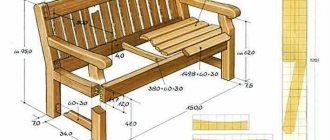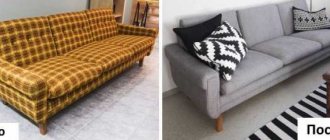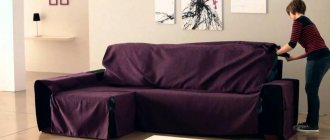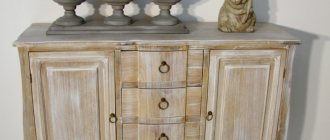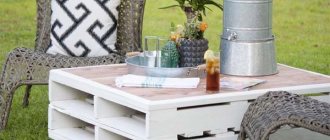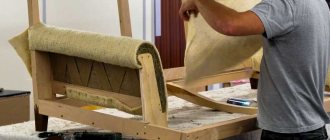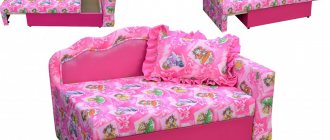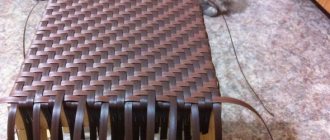Repair and decoration
05.15.2018 Anastasia Prozheva
Currently, frameless upholstered furniture has gained great popularity. It does not have a rigid frame; it is a true embodiment of upholstered furniture. Today in a furniture store you can buy frameless sofas, armchairs, ottomans, and beds.
One of the options for a frameless sofa. made by hand..
But the price of these fashionable things is quite high. However, you can make frameless furniture with your own hands.
By making a frameless sofa with your own hands, you will receive a wonderful, original, exclusive item.
Nowadays, frameless sofas consisting of several volumetric pillows are very popular. This product can be easily moved and transformed into comfortable chairs.
Selection of materials
Frameless furniture consists of several elements - upholstery and filling. In this case, the selection of materials must be approached with great responsibility, because the service life of the future product will depend on their quality. You should especially carefully choose the fabric for the furniture cover.
Cases
When making a cover for frameless furniture with your own hands, you need to give preference to practical, non-fading and non-fading fabrics. As this part becomes dirty, it will have to be washed, so the material must withstand cleaning well and retain its shape and size when exposed to high temperatures. Most often, the following are used to make frameless furniture upholstery:
- Velours. Soft fleecy fabric that is pleasant to the touch. It is easy to process, but does not collapse under mechanical stress. Excellent for making furniture for the living room, it fits seamlessly into both classic and modern interiors.
- Flock. Suitable for creating products intended for children's rooms. Does not fade in the sun and is easy to clean without absorbing dirt.
- Chenille and jacquard. Natural fabrics with the addition of synthetic fibers that increase strength and facilitate care.
- Faux leather. Gives furniture an attractive appearance and durability.
- Tapestry. Natural fabric with weave of fibers of various compositions. As a rule, it is decorated with thematic images and attractive patterns.
- Oxford. Contains polyester fibers, withstands increased mechanical loads, and is resistant to temperature changes. Ideal for frameless furniture placed in the garden.
The use of silk, satin or calico is not allowed. Such fabric will quickly deteriorate. If you plan to create two covers - internal and external, choose cotton or synthetics for the first, and wear-resistant and practical material for the second.
Velours
Flock
Jacquard
Faux leather
Tapestry
Oxford
Filler
When studying master classes on the production of frameless furniture, every novice craftsman becomes familiar with the materials used as filler. Generally, polymer beads are recommended. The correct selection of their size and quantity determines how convenient the product will be during regular use.
Hard materials are not needed to make frameless furniture. The tightly sewn fabric of the cover serves as a soft frame filled with special granules from the inside. Various materials are used as content: from natural to synthetic. White polystyrene granules are more often used - an environmentally friendly, moisture-resistant material.
For oversized furniture, raw materials made from small-sized granules are better suited - the loose mass will be evenly distributed throughout the internal space of the bag, occupying two-thirds of its volume. If you plan to make a large sofa without a frame, it is better to make a choice in favor of a larger fraction. It is possible to use other fillers, such as polystyrene foam, foam rubber, down or feathers, but they are not durable. Foam pieces break down over time, and traditional soft materials clump and cause an allergic reaction.
Advantages of individual furniture design, stages of work
Sometimes environmentally friendly raw materials are used as filler for frameless products: cereals or peas, beans, beans. You can achieve the desired effect with their help, but the finished furniture will be too hard and not suitable for long-term rest. Legumes attract the attention of rodents and serve as breeding grounds for insects. When wet, they will begin to rot and suffer from mold. The weight will also increase significantly, which will not allow you to constantly move the furniture.
Polymer balls
Creation of the third part
Attach a pattern of a rectangular piece measuring 80x60 cm to the wrong side of the material. Add 3 cm on each side to the larger rectangle, which are necessary for sewing on the zipper. 4 square pieces of 20x20 cm are cut out of the material, then two zippers are sewn to the extreme sections of the large rectangle. If the zippers are longer than the required length, the excess part is simply left inside. Zippers for parts are necessary so that you can carefully install the foam into the finished case.
Creation of the fourth part
Patterns of the following five elements are attached to the wrong side of the material:
The finished sofa is easy to assemble and disassemble.
- two rectangles 30x20 cm;
- two rectangles 80x20 cm, which will be intended for making the bottom of the pillow. One piece measuring 80x78 cm. All fragments are cut out taking into account seam allowances. Then connect both rectangles for the bottom of the cover and sew a zipper on the fold. The edges of the 30x20 cm parts must be rounded to give the product smooth outlines. All elements are sewn from the wrong side. Foam rubber is sheathed with satin, silk or other sliding fabric. This is necessary to make it easier to install the filler into the case.
If you plan to create a corner frameless sofa, then you need to make another part, exactly the same as the fourth.
Related article: Do-it-yourself finishing of interior doors: coating options
Return to contents
Tools, consumables and accessories
To assemble frameless furniture, you should use high-quality consumables and fittings. For successful production you will need:
- Reinforced threads that fasten elements together. They have increased strength, allowing them to withstand long-term use in harsh conditions.
- Tractor or spiral zipper.
- A sewing machine equipped with No. 100 needles, capable of working with thick and heavy fabric.
- Sharp tailor's scissors, with which you can easily and evenly cut any type of fabric.
- Wax chalk, necessary when transferring patterns for frameless furniture to the material.
- Expanded polystyrene.
- Buttons, rivets, Velcro, which will be used as decorative elements.
- Scotch.
The amount of fabric and fittings varies depending on what kind of furniture is being worked on. Before you start sewing, you should create a pattern and make calculations. The information obtained will help you purchase the required amount of fabric and consumables for frameless furniture.
Reinforced threads for fastening elements together
Tractor type zipper
Sewing machine
Sharp tailor's scissors
Wax chalk for patterns
Expanded polystyrene as a filler
Decor elements
Scotch
Making a frameless prefabricated sofa
The design of the product consists of three prefabricated folding chairs.
Materials and tools:
Sketch drawing of a frameless sofa.
- high-strength furniture fabric (length 3 m, width 1.5 m);
- foam rubber (5 sheets measuring 10x100x200 cm);
- zippers (7 pieces 80 cm long);
- strong reinforced threads;
- PVA glue;
- scissors;
- chalk;
- ruler;
- sewing machine.
The design of the future sofa consists of folding chairs that can be transformed into beds. One such chair consists of 4 parts. Each part is made of two pieces of foam rubber. It is necessary to cut the foam into the following fragments:
- square cut measuring 80x80 cm - 2 pcs.;
- rectangular piece 80x60 cm - 2 pcs.;
- rectangular piece 80x20 cm - 2 pcs.;
- rectangular cut 80x30 cm - 2 pcs.
We make blanks for one chair. Using PVA glue, glue two sheets of foam rubber for each part. Thus, you will get 4 blanks with a thickness of 20 cm.
Related article: Indigo wallpaper in the interior
Return to contents
Choosing a shape and creating a pattern
In the simplest cases, the shape of a circle or oval is chosen as the basis for frameless furniture. It does not require a complex pattern. However, there are quite a few modifications of such furnishings: pear, pouf, bag, and so on.
| Name | Peculiarities |
| Bag | It is given a round or slightly elongated shape, reminiscent of standard chairs with armrests. Suitable for installation in the living room. Can be used by both adults and children. |
| Pear | It is made in the shape of an oval without corners and additional components. Can have a wide variety of sizes. An excellent option for placement in the garden. |
| Pillow | A rectangle designed to be installed on the floor and large enough to comfortably accommodate one person. An ideal option for frameless furniture for adult relaxation. |
| Poof | Outwardly it resembles a barrel. A compact piece of furniture that does not take up much space and is convenient for daily use. |
| Ball | The product is perfectly round or close to a ball. Organically complements the interior of a children's room. |
| A drop | Shaped like a pyramid. When sitting, it supports both the back and the head. Suitable for children and adults. |
| Frameless sofa | Complex furniture made by fastening together several rectangular modules. Due to the lack of a frame, they are connected only by fabric, so the fastenings must be reinforced. The best option for a family holiday. |
If you follow the recommendations and operating procedure, the described products can be easily made independently. The most complex sofas may have a folding design, but this type of tailoring of frameless furniture is most often available only in factory conditions.
The drawing can be drawn up from scratch or a diagram taken from open sources can be adapted to the given dimensions. However, for this you need to have well-developed drawing skills, so most often ready-made calculations are used for handicrafts. Specialized companies, for a fee, develop drawings from scratch according to the customer’s specifications, which will make it possible to easily produce unique upholstered furniture for the home or garden.
What is modern furniture made of, an overview of the main materials
Bag
Pear
Pillow
Poof
Ball
A drop
Frameless sofa
Drawing for a large pear chair
An example of a ball chair pattern
Creation of the second part
The parts are connected to each other by stitching a strip of fabric.
Related article: Sanding walls after puttying
Fasten a rectangular pattern 80x60 cm from the wrong side of the material. Add two cm of seam allowance. Cut out parts from fabric. Then attach the pattern of a rectangular piece 120x20 cm. Seam allowances are added again. Cut out a fragment. Dense material of the same dimensions is sewn to its wrong side to strengthen the fabric. Then cut out two rectangles 160x20 cm, taking into account seam allowances. Then the cover is completely sewn together, the seams are processed, and trimmed with piping for strength. Only after this is foam rubber installed inside the cover.
Return to contents
Volume calculation
Normally, to assemble furniture without a frame, it is enough to fill the inner bag two-thirds full, but difficulties may arise when purchasing filler. The volume can be calculated using complex mathematical calculations, but the result obtained should also be revised taking into account the operating conditions. The polystyrene foam from which the filler is made wrinkles over time as air escapes from it. This leads to a decrease in working volume, so chairs and sofas are filled “with a reserve”.
Polymer granules are sold in 100 liter bags. When purchasing them, you should consider certain recommendations:
- If the chair is used frequently throughout the year, every 2-3 months it is necessary to additionally pour 40-50 liters of filler inside. If the furniture belongs to a person with a large build, the volume of added mass can be increased to 100 liters.
- Filler consumption is determined by the size of the furniture. Normally, one bean bag with dimensions of 120 x 90 cm requires 400 liters of polystyrene foam.
- The volume of polymer bulk mass is determined by the type of material used for external upholstery. Durable fabric reduces the load on the contents, allowing you to extend the period between refills. Shrinkage is accelerated if the bag is made of soft textiles or filled with low-quality polystyrene foam.
If you intend to regularly use the furniture, you should purchase the required volume in advance - 200-300 liters of polystyrene foam, so that you do not have to purchase it later. The choice should be made in favor of high-quality material to reduce its consumption and increase the level of comfort.
Filler
The filling for the bag chair is foam balls (expanded polystyrene with a density of at least 25 kg/m3). Since the balls tend to wrinkle (and after a few months the chair will shrink), you can add 30-40% synthetic fluff. Thus, the chair will be able to restore its shape and will look more voluminous.
Approximately 300-350 liters of filler will be needed. Estimated cost: $7-10 per 100l. You can purchase polystyrene foam granules at the construction market or store. But even if you can’t find it in granules, you can always buy polystyrene foam in sheets and crumble it (although this procedure takes a lot of time and after it there can be a lot of garbage in the room).
When sewing, be sure to use the strongest threads so that your chair does not fall apart at the seams after you plop down on it with acceleration.
Manufacturing stages
Before making frameless furniture, you should clearly define the procedure. Assembly technology includes:
- Design creation. The author chooses the color, model, type of fabric, decorative elements with which he will work.
- Pattern. The fabric used to make the covers is cut according to a previously prepared pattern. The inner bag and the upholstery must match each other in shape. This stage requires great precision, so you should work exclusively by hand.
- Sewing. The blanks are sewn together. A zipper is added at the bottom. The threads used must be strong, since the product is subject to serious mechanical stress.
- Filling. Filler granules are poured into the finished covers, after which the furniture assembly is considered complete.
Cutting out the parts
The material used to sew the inner cover is spread on the floor with the wrong side facing up. A pattern is applied to it, after which the optimal cutting option is calculated, allowing for effective use of the fabric. Next, drawings are made. The pattern is pinned to the material, the pattern is traced along the contour with a margin of a centimeter, after which the finished part is cut out with scissors.
It is much more convenient if two people work. In this case, one holds the stencil in place, preventing it from sliding to the side, while the other traces. With this approach the process will speed up significantly.
The elements of the outer bag and bottom are made in a similar way. You should make sure that all fragments correspond to the overall plan, otherwise problems may occur during the assembly process. At best, they will spoil the appearance of the product, at worst, they will not allow all the parts to be connected.
Making upholstered furniture with your own hands, tips for beginners
Trace the pattern on the back of the fabric
Using scissors we cut out the finished parts
Sewing covers
Once the pieces are prepared, you can start sewing. The procedure will require accuracy and the ability to strictly follow the procedure. Master class on sewing a cover for frameless furniture:
- The wedges are joined together by folding them right side inward and joining along one edge. In this case, it is necessary to leave an allowance of 10 mm.
- Stitching is done on the front side of the wedges.
- A zipper is sewn into one side, the length of which should exceed 40 cm.
- There is a Velcro fastener at the top that prevents the cover from getting wrinkled during use.
- Next, the outer cover is formed. Manufacturing is carried out according to the same principle, but in this case it is necessary to use a longer zipper. The optimal size of fittings is 1 meter.
- Velcro is attached to the bag.
- The inner cover is placed inside the outer cover so that no folds form on the surface of the furniture.
Connecting the wedges
We sew with an allowance of 10 mm
We sew in a zipper
At the top we attach Velcro so that the cover does not wrinkle
We make the outer case using the same principle.
Carefully place the inner case into the outer one
Filling the bag
During the assembly process, many people have problems and questions about how to properly fill the inner bag of frameless furniture. Plastic balls get clogged in one direction, form voids or fall apart in the process. Simple recommendations will help you avoid such problems:
- The inside of the case is treated with antistatic agent. Spraying the spray will prevent polymer granules from sticking to the walls.
- A two-liter plastic bottle with a narrow neck is selected.
- The bottom and neck of the homemade funnel are cut off, after which the bottle is inserted into the case with the narrow part and secured with tape.
- The second part of the plastic container is placed in a package with filler and is also tightly fixed.
- Through the created chute, plastic balls from the bag are poured into the inner furniture cover.
The method is extremely convenient and allows you not to spill a single fragment of polystyrene foam. The plastic from which the bottle is made has a slippery texture, so the balls do not stick to the surface.
Manufacturing technology
If a beginner is doing the work, then it is advisable to initially try to make a simple product, for example, a bean bag chair, and after obtaining a high-quality result, you can try to make complex, unusual and original models.
How to make frameless furniture? The procedure is considered simple, but is implemented in successive stages, each of which has its own characteristics. First, materials for work are selected, after which the base is formed. Next, patterns are made or found and furniture covers are created. The internal element is filled with padding material, which will allow you to get a beautiful and original product.
Forming the Foundation
The simplest options use a round or oval base. If you have experience creating patterns, you can try to make more complex options. Although due to the soft filler, represented by balls of foam rubber, polystyrene foam or other materials, the products do not hold their shape, the furniture should still have a certain appearance. Due to the ability of furniture to follow the contours of the human body, such products are classified as orthopedic.
The shape of the products depends on the type of furniture chosen.
Type of furniture Its shape
Bean bag chair Has a standard round or slightly elongated oval shape. This configuration is similar to standard products that are not equipped with armrests.
The pear chair has an oval shape and completely lacks corners or additional elements.
Chair-cushion It is represented by a small rectangle, so it does not take up much space.
Pouf Its shape can be a cylinder or a square. Such frameless furniture does not require much space and is convenient to use.
The ball is a round product with different sizes.
Pyramid Has a corresponding triangular shape. The advantage of choosing such furniture is that it perfectly supports not only your back, but also your head.
The sofa consists of several modules with a rectangular shape. Due to the lack of a frame, they are connected only by fabric, and certain models can be transformed into a bed.
Poof
Cushion chair
Bag chair
Ball
Armchair
Sofa
Thus, you first need to choose the type of furniture, after which its shape and size are determined. The base is created using durable fabric, for which the following steps are performed:
- The furniture that will be formed with your own hands is determined;
- The material for the inner bag is selected;
- A drawing is constructed using suitable tools;
- Patterns are transferred to the selected material using chalk;
- All base elements are carefully cut out;
- They are sewn together using strong threads, leaving space for a zipper;
- A zipper is sewn in.
The resulting base is ready for filling with filler.
Choosing fabric
Making a drawing
Making patterns
Sew patterns
Sew in a zipper
Upholstery selection
Upholstery is used to create an outer cover. The most frequently selected fabrics are those that are characterized by high strength, density, and resistance to stains. They can easily withstand various impacts and last a long time. For the manufacture of frameless furniture, it is not advisable to choose silk, satin or calico, as they quickly lose their attractive appearance during use.
To create the inner cover, a fabric with high strength and density is selected; for the outer cover, decorative fabrics are used. To create the inner cover, a fabric with high strength and density is selected, but the appearance does not matter, so standard white material is usually purchased.
The most suitable materials for sewing frameless furniture are:
- Velor is a soft fleecy fabric, pleasant to the touch and pliable to use;
- Flock is ideal for furniture installed in a children's room. The material does not fade, is easy to clean and wash;
- Chenille is a natural fabric with the addition of synthetic fibers, so the material is highly durable and easy to care for;
- Jacquard is also formed using synthetic fibers and has good strength. It is easy to work with and easy to care for afterwards;
- Artificial leather – easy to care for, attractive in appearance and highly durable;
- Tapestry is a natural fabric in which the interweaving of fibers is easily visible, and to create it, threads of different colors are used, which intertwine to form beautiful patterns.
We sew the inner bag from any unnecessary but durable fabric in neutral shades, and the outer bag should not only be reliable and durable, but also stylish in appearance.
Chenille
Flock
Natural jacquard
Faux leather
Tapestry
Velours
Pattern
Sewing bags requires patterns of frameless furniture, which can be made on paper yourself or downloaded from the Internet. Usually on different websites you can find photos of the furniture itself along with patterns. In this case, you can choose the optimal model, print out the diagrams, transfer the elements to the fabric and sew the bag.
If you plan to make patterns yourself, then this process is performed in sequential steps:
- It is determined what size the product will have;
- It is decided what parts it will consist of;
- Special tracing paper with 2.5 or 5 cm cells is prepared;
- All future furniture elements are marked on paper, and if a bean bag chair is created, then 4 sidewalls, 2 round parts and rectangular sections for the handle, if provided, are created;
- During work, you must use a ruler, pencil, compass and other writing instruments to ensure the evenness and correctness of the elements;
- Next, you need to make seam allowances to obtain patterns that differ in clearly matched cuts and the direction of the warp thread.
Once the necessary pattern for a specific frameless furniture has been prepared, the elements are transferred to the fabric. For this, special wax or regular chalk is used. It is advisable to make the bottom double to increase strength. Patterns are transferred with a small seam allowance of 1 to 1.5 cm, if the patterns are made without taking them into account. If you have difficulties creating patterns, you can contact the studio, where specialists will quickly cope with this task.
Determining the dimensions of the chair
We purchase tracing paper
Making elements of future furniture
We create patterns
How to sew
Once all the parts are prepared, you can start sewing. The master class for creating cases with your own hands consists of the following steps:
- Initially, the wedges are sewn together, for which they are folded with the front side inward and connected on one side, while it is important to leave an allowance of approximately 10 mm;
- The front side of the wedges is stitched;
- A zipper is sewn into the side of one side, and it is desirable that its length be at least 40 cm, as this will ensure ease of filling the bag with granules;
- At the top of the cover you need to sew Velcro to ensure that the cover inside will not wrinkle;
- The inner bag is filled with the selected granules;
- After creating this element, the production of the outer case begins, the same principle is used for this;
- The difference is a longer zipper (about a meter);
- Velcro is attached to the inside;
- The inner cover is inserted into the outer one, after which the Velcro is connected.
To strengthen the seams, you can overlock them or fold the allowances, after which a stitch is applied to them. Properly sewn frameless furniture will be beautiful and durable, and will also cope well with different loads.
Sewing the wedges
Sew in a zipper
Sew on Velcro
Fill the bag with granules
Making an outer case
Insert the outer cover into the inner one
What to fill with
Frameless products are distinguished by the absence of any solid objects; they are filled only with special granules. Fillers are usually sold by companies involved in insulating various structures.
The most popular are polystyrene granules, they are:
- They have a white color;
- They are environmentally friendly and therefore safe for people;
- Have water-repellent properties;
- Reasonable price.
For frameless furniture, it is advisable to choose small granules that are easily distributed in the bag. The required number of elements depends on the dimensions of the covers. Bags are filled 2/3 full.
In addition to polystyrene granules, you can use elements made from foam plastic, but they are quite fragile. Some people prefer to use down or feathers to fill their cases, but over time they get lost and can also cause allergic reactions.
Decorating ideas
When making frameless furniture with your own hands, it is possible to use various decorating techniques. If high-quality and beautiful fabrics are used for upholstery, the piece of furniture created from them will look attractive without decoration, but there is always an opportunity to improve the result. For decoration the following are used:
- Applications. Perfect for children's frameless furniture models. May contain images of characters from popular cartoons, fairy-tale characters, and animals.
- Embroidery. It is created with your own hands from durable and bright thread and can represent inscriptions, initials of the owners and even paintings. Such decorative elements make it possible to unique not only the furniture design, but also the interior of the entire room.
- Pockets. Sewn separately, can be used as a place to store various small items. The best option for garden products.
There are many interesting ways to decorate frameless furniture. The easiest way is to use a special cape made of soft material with pile. Design possibilities are limited solely by the imagination of the future owner of a stylish and comfortable piece of home furnishings.
Frameless upholstered furniture
Bulk bags are made in the form of sofas and armchairs. The most common one is called “pear” and looks similar to this fruit. Frameless furniture in the interior is used in any room. It looks harmonious in a room with a minimalist design; bright models are used in the nursery. The bean bag chair can be installed in the kitchen, bedroom, loggia or outdoor recreation area. Frameless furniture fits perfectly into office design and is a sign of creativity and creates an atmosphere of ease. It provides an excellent opportunity to relax, unwind and read.
Frameless furniture - advantages
Sofas and armchairs are constantly being improved. Frameless furniture is one of the brightest new products that has many advantages:
- comfort and softness. The product takes the shape of the body of the person sitting in it, supports the back well, and is comfortable to be in in any position - half-sitting, half-lying;
- injury safety. The chairs are ideal for children and do not have sharp corners;
- mobility. Frameless modular furniture is lightweight, quickly rearranged, and you can combine different designs from several sections with your own hands;
- design. The models are striking in their variety of sizes and shapes; the removable cover can be replaced with a different color if desired. The products are suitable for youth and children's interiors, studio apartments, and recreation areas;
- the ability to wash the removable top cover at home;
- high thermal insulation. Polystyrene foam allows the use of furniture even in frosty conditions, for example, while fishing in winter;
- impossibility of breakdown. If the cover breaks, the furniture can be easily repaired with your own hands;
- hypoallergenic, due to the naturalness of the materials for the top and the polymericity of the filler;
- it’s easy to make frameless furniture with your own hands;
- affordable price.
Disadvantages of frameless furniture
Like any interior item, bulk bags have their drawbacks, but they are minor:
- The chairs do not have legs , they constantly rub against the floor covering, the cover becomes unusable after a couple of years or requires washing (but is easy to replace).
- No linen drawer.
- Inconvenient for older people because they have a low rise.
- Adult or children's frameless furniture is not suitable for every interior style ; for example, it is inappropriate in classics.
- Styrofoam balls become wrinkled over time - they need to be renewed and filler purchased.
Photo
Filling the case with granules
Then they proceed to filling the case with foam granules. This is done like this: take a 1.5 liter plastic bottle, cut off its neck and bottom so that you get a pipe. If the bottle has a waist, even better. After this, you need to open the bag with the filler, insert the bottle into it and tape it to the bag with tape. Make sure that the neck of the bag is completely secured with tape so that the balls will only fall through the bottle.
You need to unzip the chair and put the cover on the bottle. After this, the zipper must be closed, securing the bottles to the waist. Holding this place with your hands, you need to turn over the bag with the filler and fill the cover to about 70% of its volume.
If there is too much filler, the furniture will not conform to the shape of the body and will be uncomfortable.
If there is insufficient filler, the fit will be low.
Pattern of a large frameless chair.
All materials for sewing furniture can be purchased at regular craft stores. The only difficulty may arise with purchasing the filler. It is usually sold by companies that produce frameless furniture or thermal insulation materials. An important criterion is the quality of the filler. It should have granules of the same size - about 5 mm. Filling with large balls does not have the proper fluidity, and you will have to distribute it over the chair manually. If the granules are too small, the chair will have a lot of weight.
Related article: Decorating a room with balloons
For stuffing chairs, so-called crushed pulp is sometimes used. This is recyclable material made from defective foam boards. This filler does not flow, and, moreover, when it collapses under the weight of a person, it can produce an unpleasant squeak. If the filler emits a strong chemical odor, it needs to be ventilated in the open air for several days, for example, by leaving a bag of filler on the balcony or pouring it into a fabric bag.
Return to contents
Master class on making a bag chair with your own hands
Frameless furniture is becoming in demand because it has numerous advantages and is attractive in appearance. It is presented in numerous varieties, but the most popular is the do-it-yourself chair bag; a master class on this process is described below. They do not have a specific and constant shape; various figures are formed from them. Frameless furniture is comfortable to use and is effectively used for sleeping. Making a structure with your own hands at home is not difficult. This will not only save significant money, but will also ensure that you receive a product that fits perfectly into the interior.
Features of a bean bag chair
The main feature of this design is the absence of a frame, which is characterized by rigidity and strength. In its classic form, it is presented in the form of a pear. It is a large fabric bag filled with various bulk materials. An unusual effect is created, as if a person is sitting on a water mattress. The product takes the shape of the body, so the weight is distributed evenly.
Bean bag chairs are created by many people at home, as this makes it possible to get a unique product that fits perfectly into the interior. This allows you not to spend a lot of money on its purchase.
After a short period of use of this chair, complete relaxation of the back muscles is ensured, so the load is removed from it. An easy chair is usually stuffed with foam plastic or other materials that have excellent thermal insulation parameters, so the design additionally has a warming effect.
Bean bag chairs are presented in numerous types, and they differ not only in size, but also in shape. It is easy to select a product that is suitable for a child or an adult, and also has a configuration in the form of a pear or a circle, a rectangle or an unusual shape. Below are many photos of these products, so when creating a chair yourself, it’s easy to choose the best option.
Scheme
The advantages of their use include the following factors:
- since loose fillers are used, the product is comfortable to use;
- furniture without a frame is safe, since it has no corners, so it is effectively used in a children's room;
- a hand-made element will fit perfectly into the interior;
- Only environmentally friendly materials are used in the work process;
- the chair moves easily around the room, making cleaning easier;
- The removable outer cover can be washed periodically, so maintenance is simple.
If the old product no longer fits into the interior, you can make a new and bright outer cover for it, which will update any room.
Dimensions
Selecting material for the case
Before you sew a bag chair with your own hands, you need to decide what fabric will be used for this process. The structure consists of elements:
- outer cover, which must be stain-resistant, durable, dense and attractive;
- inner cover made of durable, breathable and reliable materials;
- filler, and it is important to first decide what the chair will be filled with.
Initially, it is decided what fabric will be used for the bean bag chairs. For the outer product, you can choose different types of fabrics. It is important that they have the following parameters:
- high strength and abrasion resistance;
- ease of maintenance, since the outer cover is most often exposed to various influences, and there is also a high probability of contaminating it;
- attractiveness, since this cover determines how the entire chair will look.
An excellent choice is Oxford fabric, which is used to form awnings or tents. It is durable and easy to maintain, making it perfect for the job you plan to do. As a rule, during production it is impregnated with special compounds that make it resistant to moisture. It is available in numerous colors, so you can choose the best option for the job. Bag chairs, the sizes of which can be different, made from this fabric, can be used not only in residential premises, but also outdoors.
Other types of fabrics, such as flock or microcorduroy, can also be used, but products made from these materials are installed exclusively at home. Your element can even be made from eco-leather, which ensures an exquisite and unique model that fits perfectly into different modern interior styles.
Microvelvet Oxford Flock Eco leather
The inner cover of bean bag chairs is usually formed from dense spunbond. It is advisable to choose a type that is equipped with small holes designed for ventilation of the product. The material is low in cost, so it is considered an excellent choice for creating an internal cover. As a rule, it is sold in rolls.
If it is not possible to choose spunbond, then any other fabric that is dense and breathable will do. If ventilation of the internal space is not provided, the filler will quickly begin to stick together, so its shape and its parameters change.
Spunbond
Necessary tools to make a beanbag chair with your own hands
The process of creating a bean bag chair with your own hands, the master class of which is presented below, begins with preparing the tools and materials that are necessary for this work. These include:
- a lot of fabric, both for the inner and outer covers;
- to obtain sealed cases, purchase two zippers of the optimal size;
- scissors will ensure cutting out the necessary elements from the fabric;
- threads are intended for fastening individual parts of the structure;
- a sewing machine facilitates the work process and also ensures smooth, beautiful and durable stitches;
- filler with which to stuff the inner case.
If you don’t have a sewing machine, you can do the work manually, but to obtain high-quality seams you must have experience in this field.
Creating a pattern
How to make a beanbag chair so that it turns out smooth and of high quality? To do this, a detailed and correct pattern is first created. It is easy to form on your own, and you can also see different types of patterns below. As a rule, they are all identical, but may differ in the size of the beanbag chair.
The whole process is divided into the following stages:
- patterns are made, and it is desirable that they initially have the required dimensions, which will subsequently affect the dimensions of the chair bag;
- the result is 4 main elements, with the help of which the bag chair is created;
- An economical option involves applying the pattern to the fabric itself, after which the necessary elements are cut out.
Patterns for bean bag chairs can be different, since they completely depend on what dimensions and other parameters the product will have after work. When creating the main parts of the product, it is important to monitor the economical use of fabric.
Sewing a cover
After creating the cutting for both covers, their sewing begins. To do this, it is important to decide in advance what the dimensions of the chair bag will be. The process is performed in the following sequence of actions:
- two flat blanks are created. To do this, all elements are fastened to each other with pins, after which the side seams should be basted on the wedges;
- the formed side seams are connected with a sewing machine or by hand, after which they are smoothed, for which it is advisable to use an iron equipped with a steam mode;
Before you start stitching the parts, fasten them with needles
- the side seams are sewn on the front side of the outer cover;
- On both workpieces, the outer wedges are folded, after which they are basted. When working with an outer cover, the remaining side seams are sewn from the bottom and top, and it is important to leave approximately 40 cm on either side, and this distance is necessary for sewing in the zipper. The same steps are performed for the inner cover, but no more than 35 cm is left for the zipper. All seams obtained are ironed;
All seams must be overlocked
- For the remaining unstitched sections, zippers are pinned or basted. Their middle should be in the center of the pressed seam. After adjustment, the zippers are sewn in;
- as a result of the actions performed, the seams of the bag will have a tube-like irregular shape, which taper slightly at the top;
How to sew a zipper correctly After the wedges are sewn together, you will get this base
- The handle of the future chair is made, for which the prepared part is folded, and only inside out. It is stitched in a place where there is a long edge. Then it is turned inside out and ironed;
- The existing blanks of both covers are turned inside out. A top is sewn to the outer cover, which is basted to the outer pipe, after which the handle is inserted;
For ease of use, zippers should be sewn into the bags.
- The bottom of both covers is ground off, and the resulting circles are attached. After the work is completed, the covers are turned right side out.
External chair cover
After creating the covers, it is important to decide what will fill the inner element. The selected filler is loaded into the product in such a way as to completely fill it. To do this, the inner cover is inserted into the outer one, and then stuffed with the selected material. After creating a beanbag chair, a pillow or other similar elements are often made that ensure the comfort of using the product.
Filler selection
Before creating this product, it is important to decide what it will be filled with. Most often, granules formed from polystyrene foam are chosen for these purposes. They are represented by small balls with high hygienic parameters. They do not absorb foreign odors. At the same time, they have excellent thermal insulation properties. The price of the material is affordable.
In addition to polystyrene foam, the following fillers can be used:
- wood shavings;
- down, feathers or wool;
- different types of cereals.
Expanded polystyrene How to properly fill a chair bag
Thus, the process of creating a bean bag chair is considered quite simple and straightforward. It is only important to choose or make high-quality and correct patterns, use suitable materials and good filler. The result is a beautiful, inexpensive and durable piece of furniture.
Now you know how to sew a chair bag. This is not difficult to do if you know what dimensions the chair bag is and choose the right materials for the job.
Video
From the video you will learn how to properly sew a chair bag.
Photos of beanbag chairs with your own hands
In the selection you can see what the finished products look like.
What is a bean bag - how to sew a chair bag
17 Feb 2013
In recent years, frameless furniture has firmly entered our interiors. The first chair without a frame was made in 1968 in Italy in the form of a film bag filled with water. But the experiment failed: under the weight of a person, according to the inexorable laws of hydraulics, the bag burst.
Still, this did not discourage the Italian designers, and soon they created a chair in the shape of a plastic pear filled with small balls. This design of a bean bag chair turned out to be successful and is still used today under different names: “ottoman”, “pillow”, “bean-bag” (in English “bean” - beans, “bag” - bag).
Comfortable frameless furniture
Bean bags are not actually filled with beans, but most often with polystyrene balls. The balls feel elastic and soft to the touch. Moving freely in the bag, thanks to the absence of bolts and screws, they quickly take the shape of a person sitting on the bag. You can sit comfortably on this chair in any position and you can relax as much as possible.
For durability and beauty, a cover of the same size with a clasp is put on the bag with the filling.
The bean bag is especially attractive for its simplicity: it is not difficult to make it yourself. We'll tell you how to sew a bean bag chair in two versions - for children and for adults.
We prepare the necessary materials and tools
Fabric for covers. The outer and inner covers will have the same dimensions. For one case you need:
We choose dense fabric for the outer cover: velor, denim, faux fur, tapestry, leather, etc. The fabric should be practical and easy to care for. The color can be any, but taking into account the color scheme of the interior.
For a child, fabric with images of funny flowers or fairy-tale characters is suitable, for a teenager - flock or denim, for an adult - plain or with a geometric pattern, for an office with a large number of visitors - leatherette or other easily washable fabric.
You can sew several outer covers of different colors if desired. Then it will be possible to change them when changing the interior or when moving from one room to another.
For the inner cover we choose thick cotton fabric, preferably calico, but raincoat fabric and mattress fabric are also suitable.
Half a meter long zipper – 2 pcs.
Filler. The filler should be light thermal insulating. You can use, for example, buckwheat husks and fragrant hay, but they are afraid of moisture, and such filling will have to be changed from time to time. The best filler is polystyrene balls of about a centimeter in diameter.
Polystyrene is a safe and environmentally friendly material. Each ball contains tens of thousands of air-filled microcells. This still air is the best insulator, so a person in such a chair does not sweat. It is comfortable to sit on both in a cold room and on the shore of a lake.
